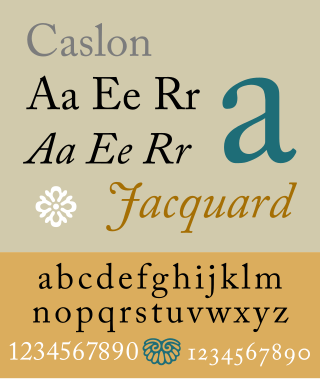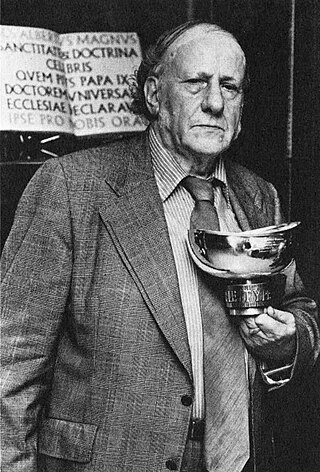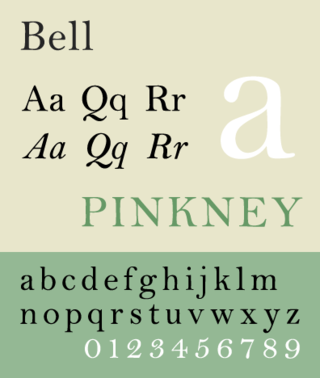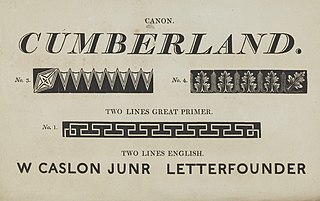
In typography and lettering, a sans-serif, sans serif, gothic, or simply sans letterform is one that does not have extending features called "serifs" at the end of strokes. Sans-serif typefaces tend to have less stroke width variation than serif typefaces. They are often used to convey simplicity and modernity or minimalism.

Thomas Secker was the Archbishop of Canterbury in the Church of England.

William Caslon I, also known as William Caslon the Elder, was an English typefounder. The distinction and legibility of his type secured him the patronage of the leading printers of the day in England and on the continent. His typefaces transformed English type design and first established an English national typographic style.

Caslon is the name given to serif typefaces designed by William Caslon I (c. 1692–1766) in London, or inspired by his work.

Berthold Ludwig Wolpe was a German calligrapher, typographer, type designer, book designer and illustrator. He was born into a Jewish family at Offenbach near Frankfurt, emigrated to England soon after the Nazis came to power in 1935 and became a naturalized British citizen in 1947. He was made a Royal Designer for Industry in 1959, awarded an honorary doctorate by the Royal College of Art in 1968 and appointed an Officer of the Order of the British Empire (OBE) in 1983. He died in London in 1989.

In typography, a slab serif typeface is a type of serif typeface characterized by thick, block-like serifs. Serif terminals may be either blunt and angular (Rockwell), or rounded (Courier). Slab serifs were introduced in the early nineteenth century.

Didone is a genre of serif typeface that emerged in the late 18th century and was the standard style of general-purpose printing during the nineteenth. It is characterized by:

Baskerville is a serif typeface designed in the 1750s by John Baskerville (1706–1775) in Birmingham, England, and cut into metal by punchcutter John Handy. Baskerville is classified as a transitional typeface, intended as a refinement of what are now called old-style typefaces of the period, especially those of his most eminent contemporary, William Caslon.

Bell is the name given to a serif typeface designed and cut in 1788 by the punchcutter Richard Austin for the British Letter Foundry, operated by publisher John Bell, and revived several times since.
Richard Austin (1756–1832) was an English punchcutter. He was the original cutter of the typefaces now known as Bell, Scotch Roman, and Porson. Born in London 4 August 1756 and christened at St Luke's Old Street, he studied seal, die and copper-plate engraving as an apprentice to John Phillips near Finsbury Square. He married Phillips' daughter Sarah and set up on his own about 1786. He was hired by John Bell's British Letter Foundry in 1788 as a punch-cutter, to imitate Didot's 1782 types "de la troisième manière," cut by Pierre Vafflard to F-A Didot's designs. Bell sold his interest in the foundry to S & C Stephenson. When the foundry closed in 1797, Austin brought in his own punches and sold strikes to Fry & Steele, Figgins, and Caslon. Strikes were even sold in North America. Austin cut Greek types for Cambridge University Press in 1806–8, following designs provided by the famous master Richard Porson. He probably also cut the Sarcophagus Greek that preceded it. Austin then provided strikes to William Miller's foundry in Edinburgh & Alexander Wilson's Sons' foundry in Glasgow, creating the types now known as Scotch, before founding his own Imperial Letter Foundry in London in 1815, with his son George. The first Miller Specimen of 1809 is now lost. Wilson's earliest specimen showing the improved types is dated 1812. Richard Austin died circa 20 August 1832, leaving the foundry to his son George, whom many credited with the innovations in type designs manifest in the Scotch types. Austin's other sons were John Phillips Austin, a music engraver, and Richard Turner Austin (1781-1842), a painter and commercial wood engraver.

Vincent Figgins was a British typefounder based in London, who cast and sold metal type for printing. After an apprenticeship with typefounder Joseph Jackson, he established his own type foundry in 1792. His company was extremely successful and, with its range of modern serif faces and display typefaces, had a strong influence on the styles of British printing in the nineteenth century.
Stevens, Shanks & Sons Ltd. was an English type foundry formed in 1933 by the merger of the Figgins Foundry with P. M. Shanks to form Stevens, Shanks. Sometime after 1971 the foundry ceased operations and all materials went to St. Bride's Printing Library.
Robert Thorne was a British type founder and typographer. An apprentice to Thomas Cottrell, who had been an employee of William Caslon, Thorne later acquired Cottrell's type foundry. He was successful in business and left a fortune of £25,000 on his death in 1820. Thorne is buried at Holloway Road Cemetery, where his tomb is extant.
James Mosley is a retired librarian and historian whose work has specialised in the history of printing and letter design.

A display typeface is a typeface that is intended for use at large sizes for headings, rather than for extended passages of body text.

Egyptian is a typeface created by the Caslon foundry of Salisbury Square, London around or probably slightly before 1816, that is the first general-purpose sans-serif typeface in the Latin alphabet known to have been created.

Anthony Bessemer was a British industrialist and punchcutter, who spent large portions of his life in the Netherlands and France before returning to live in London and Hertfordshire. His son was Sir Henry Bessemer, the inventor of the Bessemer process for steel manufacture.

In typography, a fat face letterform is a serif typeface or piece of lettering in the Didone or modern style with an extremely bold design. Fat face typefaces appeared in London around 1805–1810 and became widely popular; John Lewis describes the fat face as "the first real display typeface."

The Caslon type foundry was a type foundry in London which cast and sold metal type. It was founded by the punchcutter and typefounder William Caslon I, probably in 1720. For most of its history it was based at Chiswell Street, Islington, was the oldest type foundry in London, and the most prestigious.

In letterpress printing, wood type is movable type made out of wood. First used in China for printing body text, wood type became popular during the nineteenth century for making large display typefaces for printing posters, because it was lighter and cheaper than large sizes of metal type.
















